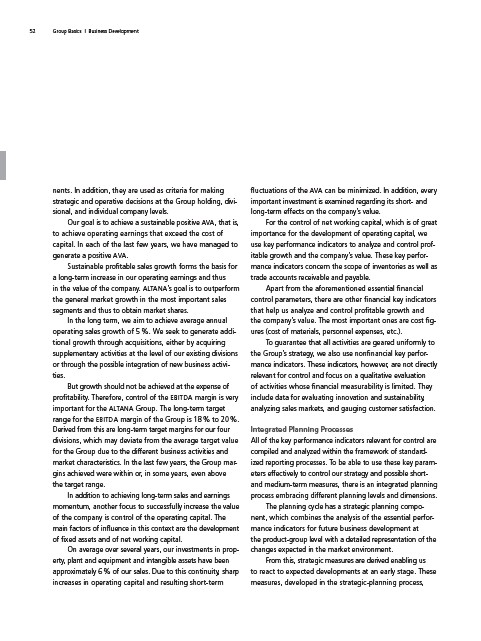
nents. In addition, they are used as criteria for making
strategic and operative decisions at the Group holding, divisional,
and individual company levels.
Our goal is to achieve a sustainable positive AVA, that is,
to achieve operating earnings that exceed the cost of
capital. In each of the last few years, we have managed to
generate a positive AVA.
Sustainable profitable sales growth forms the basis for
a long-term increase in our operating earnings and thus
in the value of the company. ALTANA’s
goal is to outperform
the general market growth in the most important sales
segments and thus to obtain market shares.
In the long term, we aim to achieve average annual
operating sales growth of 5 %. We seek to generate additional
growth through acquisitions, either by acquiring
supplementary activities at the level of our existing divisions
or through the possible integration of new business activities.
But growth should not be achieved at the expense of
profitability. Therefore, control of the EBITDA margin is very
important for the ALTANA
Group. The long-term target
range for the EBITDA margin of the Group is 18 % to 20 %.
Derived from this are long-term target margins for our four
divisions, which may deviate from the average target value
for the Group due to the different business activities and
market characteristics. In the last few years, the Group margins
achieved were within or, in some years, even above
the target range.
In addition to achieving long-term sales and earnings
momentum, another focus to successfully increase the value
of the company is control of the operating capital. The
main factors of influence in this context are the development
of fixed assets and of net working capital.
On average over several years, our investments in property,
plant and equipment and intangible assets have been
approximately 6 % of our sales. Due to this continuity,
sharp
increases in operating capital and resulting short-term
fluctuations of the AVA can be minimized. In addition, every
important investment is examined regarding its short- and
long-term effects on the company’s value.
For the control of net working capital, which is of great
importance for the development of operating capital, we
use key performance indicators to analyze and control profitable
growth and the company’s value. These key performance
indicators concern the scope of inventories as well as
trade accounts receivable and payable.
Apart from the aforementioned essential financial
control parameters, there are other financial key indicators
that help us analyze and control profitable growth and
the company’s value. The most important ones are cost figures
(cost of materials, personnel expenses, etc.).
To guarantee that all activities are geared uniformly to
the Group’s strategy, we also use nonfinancial key performance
indicators. These indicators, however, are not directly
relevant for control and focus on a qualitative evaluation
of activities whose financial measurability is limited. They
include data for evaluating innovation and sustainability,
analyzing sales markets, and gauging customer satisfaction.
Integrated Planning Processes
All of the key performance indicators relevant for control are
compiled and analyzed within the framework of standardized
reporting processes. To be able to use these key parameters
effectively to control our strategy and possible short-
and medium-term measures, there is an integrated planning
process embracing different planning levels and dimensions.
The planning cycle has a strategic planning component,
which combines the analysis of the essential performance
indicators for future business development at
the product-group level with a detailed representation of the
changes expected in the market environment.
From this, strategic measures are derived enabling us
to react to expected developments at an early stage. These
measures, developed in the strategic-planning process,
52 Group Basics I Business Development